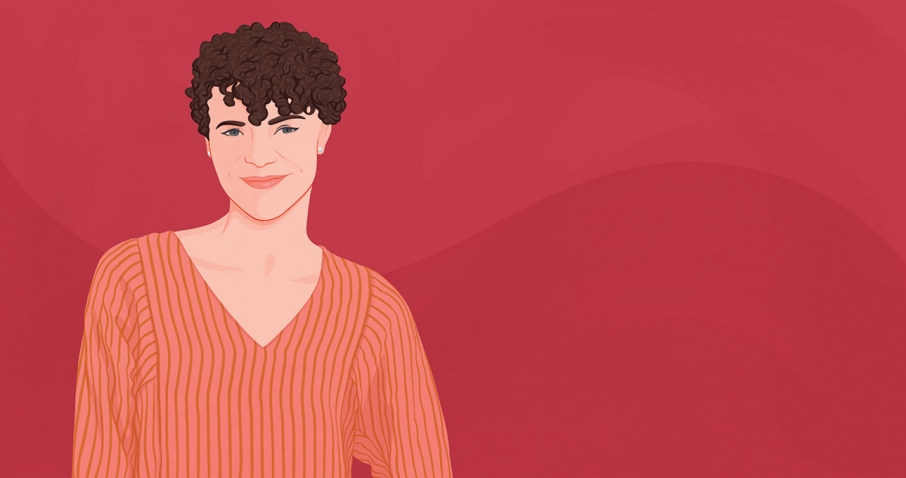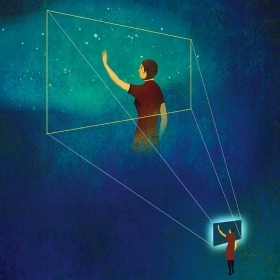Illustration by Louisa Cannell
Students toil away on research papers, only to find their hard work almost always has an audience of one—their professor. But what if class projects could have a much wider reach? Rebecca Darling helps faculty and students discover ways to achieve just that.
As a staff member who specializes in instructional technology, Darling spends her days showing students and professors how to tap into technology to make class assignments more dynamic and, in the process, more accessible and inclusive for students with a wide variety of learning styles, language backgrounds, and disabilities.
“Having different options and tools allows all students to express their knowledge,” Darling says. “If we can raise the general accessibility of courses, then more students get benefits from that. That’s the vision.” Technology can help level the playing field.
Recently, Darling helped students in a Women’s and Gender Studies course choose tools to create their final assignment. One student designed an interactive fiction project—a text-heavy, choose-your-own-adventure-like video game—using open-source tool Twine. The student explored the path of a pregnant woman of color as she sought out medical support. Darling has also worked with students to produce digital stories—three- to five-minute self-filmed videos that argue a point—and podcasts.
Students often share the digital stories and other projects they’ve created in a class Google drive so peers, family, and friends can engage with the content. “It adds another level of accountability and value,” Darling says. “Students often give more effort and they take more ownership of the work they’re creating.”
One student created a digital story about how immigration policies have affected her family, while another took a first stab at video editing with a digital story about transgender athletes. Boston Children’s Hospital used the student’s video during its LGBTQ awareness week.
“We were able to create something the student really felt attached to and that had value,” Darling says. “Some of these students are jumping way outside of their comfort zones. The amount of creativity and richness and thought going into these projects is extraordinary.”
Other faculty and students in foreign language courses use video annotation tool VoiceThread, which allows students to create, share, and comment on presentations outside of class. The technology helps enhance comprehension and spurs dialogue around classwork.
Much has changed since Darling began her career at Wellesley, when she started out in the library’s Knapp Media and Technology Center in the 1990s delivering overhead projectors to classrooms, then managed the College’s Mac computers. She gradually transitioned to her role in instructional technology, helping students and faculty use tech in their teaching and learning.
Darling and her team of three also help faculty get up to speed on learning management systems like Google and Sakai, and partner closely with Wellesley’s reference librarians and Office of Accessibility and Disability Resources. Her work helps foster the College’s commitment to inclusive excellence, supporting students of all races, ethnicities, nationalities, genders, and socioeconomic classes, whether they’re first-generation, have disabilities, or struggle with mental or physical health.
In a workshop for faculty last year, Darling demonstrated how to make PDFs more accessible by making sure text is selectable and tagging images with descriptions. Both allow a screen reader to read the texts out loud for students. Those with vision problems benefit, as do athletes who can listen to coursework while training. These technologies may also touch other students who haven’t disclosed disabilities or those who haven’t been tested and so don’t qualify for accommodation benefits.
With more accessible course materials, all students can engage with content without having to ask for accommodation. “In reality, these types of tools really benefit a much broader group of students than you might initially expect,” Darling says.
This story was written before the extent of the COVID-19 crisis was known. Darling and her team were instrumental in helping the College convert to online learning.








We ask that those who engage in Wellesley magazine's online community act with honesty, integrity, and respect. (Remember the honor code, alums?) We reserve the right to remove comments by impersonators or comments that are not civil and relevant to the subject at hand. By posting here, you are permitting Wellesley magazine to edit and republish your comment in all media. Please remember that all posts are public.